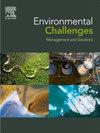Spatiotemporal assessment of environmental change in Kushtia, Bangladesh (1998–2023) using remote sensing-based environmental indices
Q2 Environmental Science
引用次数: 0
Abstract
Bangladesh’s rapidly evolving environment, influenced by land use and climate dynamics, requires effective monitoring systems. This study examines spatiotemporal environmental changes in Kushtia from 1998 to 2023, utilizing NDVI, NDWI, NDMI, and LST derived from multi-spectral satellite imagery. A PCA-based weighted overlay method integrates these indices into a composite index to evaluate each year's overall environmental condition. Satellite images were processed in ENVI 5.3 and analyzed in ArcGIS 10.8, while PCA determined the weights of the indices. The weighted indices were overlaid in ArcGIS Pro 3.01, and image differencing was applied to detect environmental changes over time. The results represent a decline in the highest NDVI value from 0.72 in 1998 to 0.47 in 2023, reflecting an 18.23 % decrease in vegetated area coverage, while water availability (NDWI) and moisture content (NDMI) declined by 57.64 % and 47.01 %, respectively. Daulatpur experienced the highest reductions, with NDWI decreasing by 72.89 % and NDMI decreasing by 83.25 %, followed by Kumarkhali, which experienced a 51.16 % decline in NDWI. LST remained stable at 32.84 °C in 2023, with weak correlations to vegetation and water indices (R² < 0.13), indicating non-climatic drivers. PCA results suggest that PC1 (55.6 %) and PC2 (38.58 %) collectively account for 94.2 % of the environmental variation, with NDWI (weight: 0.312) and NDVI (weight: 0.298) as the dominant factors. PCA-weighted analysis reveals that degraded areas have shown improvement, while high-performing zones have experienced a decline. Environmental change was more significant from 1998 to 2010 than from 2010 to 2023, with notable degradation and recovery in Mirpur and Daulatpur. The findings emphasize the importance of adequate water governance, afforestation, and adaptive policies in addressing vegetation health and water stress.
基于遥感环境指数的孟加拉国库什蒂亚环境变化时空评价(1998-2023
孟加拉国受土地利用和气候动态的影响,环境变化迅速,需要有效的监测系统。利用多光谱卫星影像的NDVI、NDWI、NDMI和LST,研究了1998 - 2023年库什蒂亚地区的时空环境变化。基于pca的加权叠加法将这些指数整合成一个综合指数来评估每年的整体环境状况。卫星图像在ENVI 5.3中处理,在ArcGIS 10.8中分析,主成分分析法确定各指标的权重。在ArcGIS Pro 3.01软件中对加权指标进行叠加,采用图像差分法检测环境随时间的变化。NDVI最高值从1998年的0.72下降到2023年的0.47,植被覆盖面积减少18.23%,水分有效性(NDWI)和水分含量(NDMI)分别下降57.64%和47.01%。Daulatpur的NDWI下降幅度最大,下降了72.89%,NDMI下降了83.25%,其次是Kumarkhali, NDWI下降了51.16%。2023年地表温度稳定在32.84°C,与植被和水分指数呈弱相关(R²<;0.13),表明非气候驱动因素。PCA结果表明,PC1(55.6%)和PC2(38.58%)共同占环境变异的94.2%,NDWI(权重为0.312)和NDVI(权重为0.298)是主导因子。pca加权分析显示,退化区呈现改善趋势,而高性能区呈现下降趋势。1998 - 2010年环境变化比2010 - 2023年更为显著,米尔普尔和道拉特普尔的退化和恢复较为明显。研究结果强调了适当的水治理、造林和适应性政策在解决植被健康和水资源压力方面的重要性。
本文章由计算机程序翻译,如有差异,请以英文原文为准。
求助全文
约1分钟内获得全文
求助全文
来源期刊

Environmental Challenges
Environmental Science-Environmental Engineering
CiteScore
8.00
自引率
0.00%
发文量
249
审稿时长
8 weeks
 求助内容:
求助内容: 应助结果提醒方式:
应助结果提醒方式:


